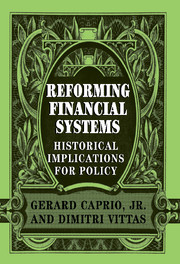Book contents
- Frontmatter
- Contents
- List of contributors
- Foreword
- 1 Financial history: Lessons of the past for reformers of the present
- 2 The evolution of central banking
- 3 Free banking: The Scottish experience as a model for emerging economies
- 4 Regulation and bank stability: Canada and the United States, 1870–1980
- 5 Deposit insurance
- 6 Contingent liability in banking: Useful policy for developing countries?
- 7 Universal banking and the financing of industrial development
- 8 Before main banks: A selective historical overview of Japan's prewar financial system
- 9 Thrift deposit institutions in Europe and the United States
- 10 The development of industrial pensions in the United States during the twentieth century
- 11 The rise of securities markets: What can government do?
- Index
2 - The evolution of central banking
Published online by Cambridge University Press: 25 March 2010
- Frontmatter
- Contents
- List of contributors
- Foreword
- 1 Financial history: Lessons of the past for reformers of the present
- 2 The evolution of central banking
- 3 Free banking: The Scottish experience as a model for emerging economies
- 4 Regulation and bank stability: Canada and the United States, 1870–1980
- 5 Deposit insurance
- 6 Contingent liability in banking: Useful policy for developing countries?
- 7 Universal banking and the financing of industrial development
- 8 Before main banks: A selective historical overview of Japan's prewar financial system
- 9 Thrift deposit institutions in Europe and the United States
- 10 The development of industrial pensions in the United States during the twentieth century
- 11 The rise of securities markets: What can government do?
- Index
Summary
Different types of economists have different views on the establishment, reform, and shape of central banks. Some think first of issues such as time consistency and the trade-off between inflation and unemployment. Others would construct an index of independence (one of these exercises in spurious accuracy that Morgenstern warned against about forty years ago). Economists with a more political bent would talk about the need for accountability of central banks in a democracy. Economic journalists are inclined to find in the Maastricht Treaty the ideal model. But economists with historical leanings think of longer-term factors and of the circumstances in which institutions might have been effective. All approaches have their uses but this chapter emphasises the contribution of history.
In this exercise we seek to say something of the historical experience and the lessons that might be learned. However, it is important to say that lessons from history are not easily uncovered. One distinguished historian suggested that the only lesson to be learned from history is that there are no lessons. History at the very minimum encourages caution and perhaps produces skepticism. The quest for lessons produces tensions in historians. The “historian” in the economic historian is content to explain events as the unique outcome of a specific set of factors; while the “economist” in the economic historian is always looking for patterns, that is, pulled toward generalization. This temptation is understandable and although it carries dangers it will be succumbed to here. The good economic historian should remain alert for the contingent while keeping an eye on the systematic.
- Type
- Chapter
- Information
- Reforming Financial SystemsHistorical Implications for Policy, pp. 22 - 40Publisher: Cambridge University PressPrint publication year: 1997
- 1
- Cited by



